-
 Bitcoin
Bitcoin $77,741.2042
-2.10% -
 Ethereum
Ethereum $1,483.7084
-5.24% -
 Tether USDt
Tether USDt $0.9996
0.01% -
 XRP
XRP $1.8283
-1.85% -
 BNB
BNB $556.0486
-0.39% -
 USDC
USDC $1.0002
0.02% -
 Solana
Solana $107.2186
-1.21% -
 Dogecoin
Dogecoin $0.1472
-1.84% -
 TRON
TRON $0.2292
-2.15% -
 Cardano
Cardano $0.5762
-1.14% -
 UNUS SED LEO
UNUS SED LEO $9.1349
1.86% -
 Toncoin
Toncoin $3.0824
-0.54% -
 Chainlink
Chainlink $11.4627
-1.15% -
 Avalanche
Avalanche $16.8086
-1.40% -
 Stellar
Stellar $0.2234
-1.98% -
 Hedera
Hedera $0.1549
-2.35% -
 Shiba Inu
Shiba Inu $0.0...01103
-2.35% -
 Sui
Sui $1.9882
-1.59% -
 MANTRA
MANTRA $6.2625
-0.24% -
 Bitcoin Cash
Bitcoin Cash $275.4681
-0.58% -
 Polkadot
Polkadot $3.4797
-3.23% -
 Dai
Dai $1.0003
0.02% -
 Litecoin
Litecoin $70.7217
-0.76% -
 Ethena USDe
Ethena USDe $0.9986
-0.03% -
 Bitget Token
Bitget Token $4.0982
-2.40% -
 Hyperliquid
Hyperliquid $12.3725
3.36% -
 Pi
Pi $0.5663
-2.21% -
 Monero
Monero $195.2899
-5.54% -
 OKB
OKB $51.4452
-1.06% -
 Uniswap
Uniswap $4.8766
-5.24%
How to trade perpetual contracts on KuCoin
Trading perpetual contracts on KuCoin involves understanding leverage, funding rates, and risk management to effectively engage with the crypto market.
Apr 04, 2025 at 07:43 pm
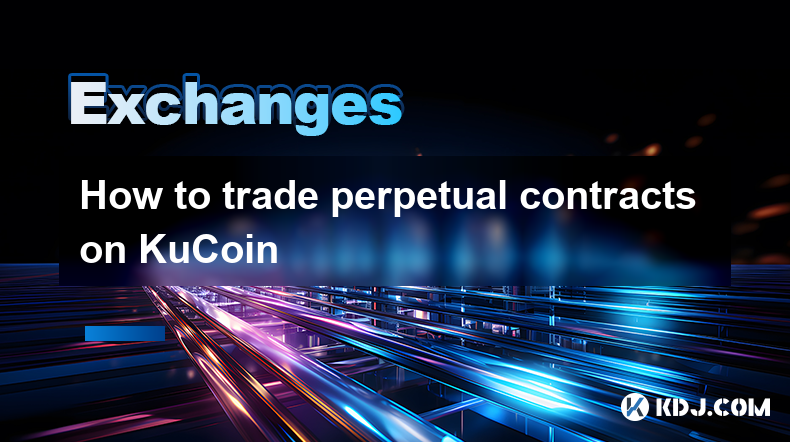
Trading perpetual contracts on KuCoin can be an exciting way to engage with the cryptocurrency market. Perpetual contracts, also known as perpetual futures, allow traders to speculate on the price movements of cryptocurrencies without an expiration date. This means you can hold positions for as long as you want, making them a popular choice among traders looking to leverage their investments. To get started, you'll need to understand the basics of how these contracts work on KuCoin, including how to open and manage positions, and how to use leverage effectively.
Understanding Perpetual Contracts on KuCoin
Perpetual contracts on KuCoin are similar to traditional futures contracts but without an expiry date. This allows traders to maintain their positions indefinitely, which is particularly useful in the volatile crypto market. On KuCoin, these contracts are traded against USDT, a stablecoin pegged to the US dollar. The key feature of perpetual contracts is the funding rate, which is paid periodically between long and short traders to ensure the contract price stays close to the underlying asset's spot price. Understanding this mechanism is crucial for managing your trades effectively.
Setting Up Your KuCoin Account
Before you can start trading perpetual contracts, you need to set up an account on KuCoin. Here’s how you can do it:
- Visit the KuCoin website and click on the "Sign Up" button.
- Enter your email address and create a strong password.
- Complete the email verification process.
- Enable two-factor authentication (2FA) for added security.
- Complete the KYC (Know Your Customer) process by submitting the required documents.
Once your account is set up and verified, you can deposit funds into your KuCoin wallet. Make sure to deposit USDT or the cryptocurrency you wish to trade.
Depositing Funds into Your KuCoin Wallet
To trade perpetual contracts, you need to have funds in your KuCoin wallet. Here’s how to deposit funds:
- Navigate to the "Assets" section on the KuCoin website.
- Select "Deposit" and choose the cryptocurrency you want to deposit (e.g., USDT).
- Follow the instructions to generate a deposit address and complete the transaction from your external wallet.
- Wait for the funds to be credited to your KuCoin account, which may take some time depending on the blockchain network.
Once your funds are available, you can proceed to the trading interface to start trading perpetual contracts.
Navigating to the Perpetual Contracts Trading Interface
To access the perpetual contracts trading interface on KuCoin, follow these steps:
- Log into your KuCoin account.
- Click on the "Trade" tab at the top of the page.
- Select "Futures" from the dropdown menu.
- Choose the perpetual contract you want to trade, such as BTC/USDT or ETH/USDT.
The trading interface will display various tools and charts that you can use to analyze the market and execute your trades.
Opening a Position on KuCoin Perpetual Contracts
To open a position on KuCoin perpetual contracts, follow these steps:
- On the trading interface, select the contract you want to trade.
- Decide whether you want to go long (buy) or short (sell) based on your market analysis.
- Enter the amount you want to trade and the leverage you want to use.
- Review your order details, including the potential profit and loss.
- Click "Buy/Long" or "Sell/Short" to open your position.
Remember that using leverage can amplify both your gains and losses, so it’s important to use it wisely.
Managing Your Position
Once you have opened a position, you need to manage it effectively to maximize your potential profits and minimize losses. Here are some tips for managing your position:
- Monitor the funding rate and adjust your position accordingly. If the funding rate is high, it might be beneficial to close your position temporarily.
- Use stop-loss and take-profit orders to automate your trading strategy and protect your investment.
- Keep an eye on market trends and news that could affect the price of the underlying asset.
- Consider closing your position if the market moves against you to limit your losses.
Effective position management is key to successful trading on KuCoin perpetual contracts.
Understanding Leverage and Margin
Leverage allows you to control a larger position with a smaller amount of capital. On KuCoin, you can use up to 100x leverage on certain perpetual contracts. However, using high leverage increases your risk, so it’s important to understand how it works:
- Leverage is the ratio of the position size to the margin required. For example, with 10x leverage, you can control a position worth $10,000 with just $1,000 in margin.
- Margin is the amount of capital you need to open and maintain a position. If the market moves against you, you may need to add more margin to avoid liquidation.
Always use leverage cautiously and ensure you have enough margin to cover potential losses.
Using Stop-Loss and Take-Profit Orders
Stop-loss and take-profit orders are essential tools for managing risk and locking in profits. Here’s how to use them on KuCoin:
- Stop-Loss Order: This order automatically closes your position if the price reaches a certain level, helping to limit your losses. For example, if you go long on BTC/USDT at $30,000, you might set a stop-loss at $29,000 to limit your potential loss.
- Take-Profit Order: This order automatically closes your position when the price reaches a profitable level. For example, if you go long on BTC/USDT at $30,000, you might set a take-profit at $31,000 to lock in your gains.
Using these orders can help you manage your trades more effectively and reduce the emotional stress of trading.
Monitoring the Funding Rate
The funding rate is a key component of perpetual contracts that helps keep the contract price aligned with the spot price. On KuCoin, the funding rate is paid every eight hours between long and short traders. Here’s how it works:
- If the funding rate is positive, long traders pay short traders.
- If the funding rate is negative, short traders pay long traders.
Monitoring the funding rate can help you decide when to open or close positions. For example, if the funding rate is high and you are long, you might consider closing your position to avoid paying a high funding fee.
Closing Your Position
To close your position on KuCoin perpetual contracts, follow these steps:
- Navigate to the trading interface and select the contract you are trading.
- If you are long, click "Sell/Short" to close your position. If you are short, click "Buy/Long" to close your position.
- Enter the amount you want to close and review your order details.
- Click "Confirm" to execute the order and close your position.
Closing your position at the right time can help you lock in profits or limit losses, depending on market conditions.
Understanding Liquidation
Liquidation occurs when the market moves against your position, and you do not have enough margin to maintain it. On KuCoin, if your position is liquidated, you will lose your initial margin. Here’s how to avoid liquidation:
- Monitor your position’s margin level closely.
- Add more margin if necessary to avoid liquidation.
- Use stop-loss orders to limit your potential losses.
- Avoid using high leverage, as it increases the risk of liquidation.
Understanding how liquidation works can help you manage your trades more effectively and protect your investment.
Analyzing Market Trends
To be successful in trading perpetual contracts, you need to analyze market trends effectively. Here are some tools and strategies you can use:
- Technical Analysis: Use charts and indicators to identify trends and potential entry and exit points. Popular indicators include moving averages, RSI, and MACD.
- Fundamental Analysis: Keep an eye on news and events that could affect the price of the underlying asset. For example, regulatory news or major partnerships can significantly impact cryptocurrency prices.
- Sentiment Analysis: Monitor social media and forums to gauge market sentiment. Tools like Twitter and Reddit can provide insights into how traders are feeling about a particular cryptocurrency.
Combining these analysis methods can help you make more informed trading decisions.
Managing Risk
Risk management is crucial when trading perpetual contracts. Here are some strategies to help you manage risk effectively:
- Diversify Your Portfolio: Don’t put all your capital into one position. Spread your risk across different assets and trading strategies.
- Use Proper Position Sizing: Only risk a small percentage of your capital on each trade. A common rule of thumb is to risk no more than 1-2% of your total capital on a single trade.
- Set Clear Trading Rules: Establish clear entry and exit criteria for your trades. Stick to your trading plan and avoid making impulsive decisions based on emotions.
- Keep Learning: The cryptocurrency market is constantly evolving. Stay updated with the latest trends and strategies to improve your trading skills.
Effective risk management can help you protect your capital and achieve long-term success in trading perpetual contracts.
Common Questions About Trading Perpetual Contracts on KuCoin
Q: What are perpetual contracts on KuCoin?
A: Perpetual contracts on KuCoin are futures contracts without an expiration date, allowing traders to hold positions indefinitely. They are traded against USDT and include a funding rate mechanism to keep the contract price aligned with the spot price.
Q: How do I set up an account on KuCoin to trade perpetual contracts?
A: To set up an account, visit the KuCoin website, sign up with your email, complete the verification process, enable 2FA, and complete KYC. Once your account is set up, you can deposit funds and start trading.
Q: What is leverage, and how does it work on KuCoin?
A: Leverage allows you to control a larger position with a smaller amount of capital. On KuCoin, you can use up to 100x leverage on certain perpetual contracts. It amplifies both gains and losses, so use it cautiously.
Q: How can I manage my risk when trading perpetual contracts?
A: Manage risk by diversifying your portfolio, using proper position sizing, setting clear trading rules, and continuously learning about the market. Use stop-loss and take-profit orders to limit losses and lock in profits.
Q: What is the funding rate, and why is it important?
A: The funding rate is paid periodically between long and short traders to ensure the contract price stays close to the spot price. Monitoring the funding rate can help you decide when to open or close positions to manage costs effectively.
Q: How do I avoid liquidation on KuCoin?
A: To avoid liquidation, monitor your position’s margin level, add more margin if necessary, use stop-loss orders, and avoid using high leverage. Understanding how liquidation works can help you manage your trades more effectively.
Q: What tools can I use to analyze market trends on KuCoin?
A: Use technical analysis tools like charts and indicators, fundamental analysis to monitor news and events, and sentiment analysis to gauge market sentiment. Combining these methods can help you make more informed trading decisions.
Disclaimer:info@kdj.com
The information provided is not trading advice. kdj.com does not assume any responsibility for any investments made based on the information provided in this article. Cryptocurrencies are highly volatile and it is highly recommended that you invest with caution after thorough research!
If you believe that the content used on this website infringes your copyright, please contact us immediately (info@kdj.com) and we will delete it promptly.
- BTFD Coin: The Next Big Meme Coin With Staking Rewards and a Play-to-Earn (P2E) Game
- 2025-04-09 16:00:13
- These 4 Altcoins (ETH, BNB, DEBO, SOL) Can Provide Insane Performance
- 2025-04-09 16:00:13
- Top 5 Performers from HTX’s Crypto Gem Hunt #2
- 2025-04-09 15:55:12
- TZ APAC Launches the Second Cohort of Its Fortify Labs Program, Targeting Startups Building on Tezos or Etherlink
- 2025-04-09 15:55:12
- Introducing A(i)gentFi, the One-Stop Shop for AI Agent Creation on ZKsync
- 2025-04-09 15:50:12
- Rain Labs Raises $15M From Galaxy Ventures, Goldcrest, Thayer, and Hard Yaka to Expand Its Global Reach
- 2025-04-09 15:50:12
Related knowledge
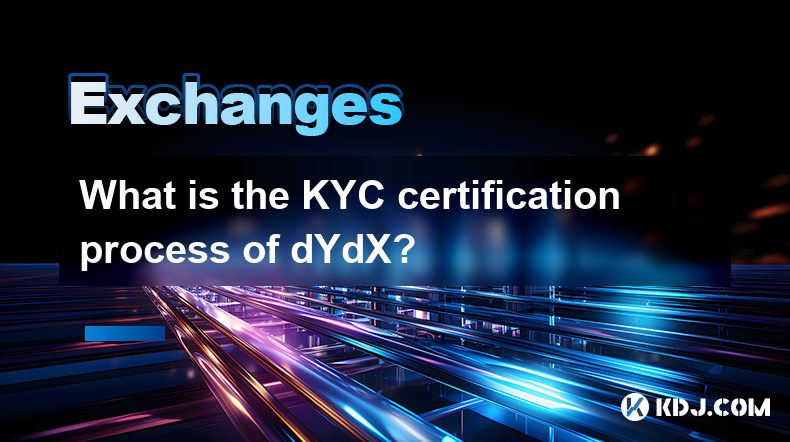
What is the KYC certification process of dYdX?
Apr 09,2025 at 02:21am
The KYC (Know Your Customer) certification process is a critical step for many cryptocurrency platforms to ensure compliance with regulatory requirements and to prevent fraud. dYdX, a leading decentralized exchange focused on perpetual futures trading, also implements a KYC process for its users. This article will detail the KYC certification process of...
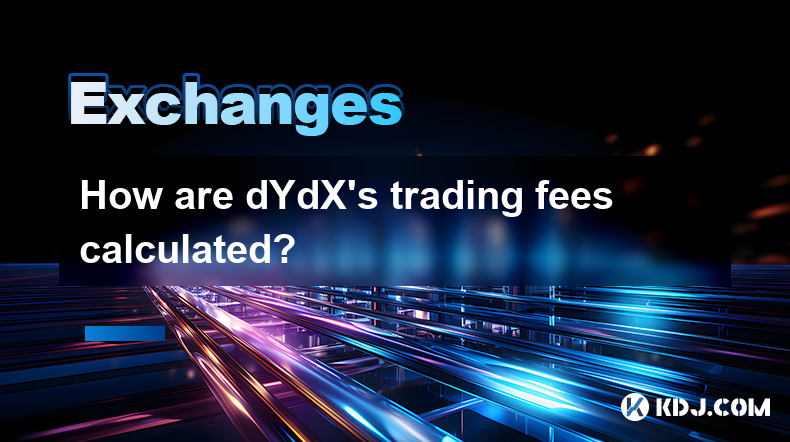
How are dYdX's trading fees calculated?
Apr 09,2025 at 03:14am
dYdX is a decentralized exchange that operates on the Ethereum blockchain, offering users the ability to trade perpetual contracts and other derivatives. One of the key aspects that users need to understand when using dYdX is how trading fees are calculated. This article will delve into the specifics of dYdX's fee structure, providing a comprehensive gu...
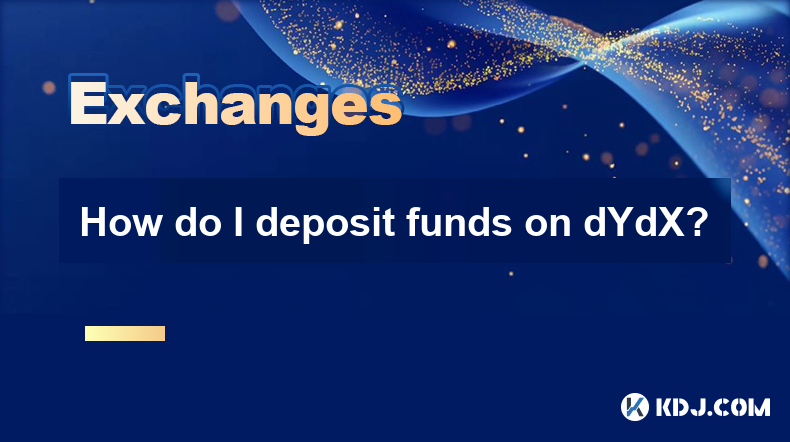
How do I deposit funds on dYdX?
Apr 08,2025 at 11:22pm
How do I deposit funds on dYdX? dYdX is a leading decentralized exchange that allows users to trade cryptocurrencies, engage in margin trading, and participate in perpetual contracts. One of the essential steps to start using dYdX is depositing funds into your account. This article will guide you through the process of depositing funds on dYdX, ensuring...
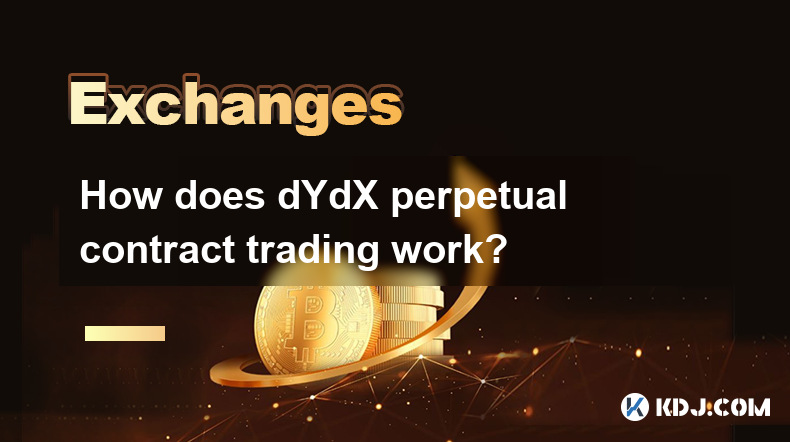
How does dYdX perpetual contract trading work?
Apr 09,2025 at 12:56pm
dYdX is a decentralized platform that offers perpetual contract trading, which is a type of derivative trading that allows users to speculate on the price movements of cryptocurrencies without owning the underlying assets. In this article, we will explore how dYdX perpetual contract trading works, including the mechanics of the platform, the benefits an...

How do I trade leveraged on dYdX?
Apr 09,2025 at 12:07pm
Trading leveraged on dYdX can be an exciting way to potentially amplify your returns in the cryptocurrency market. dYdX is a decentralized platform that allows users to trade with leverage, meaning you can borrow funds to increase your trading position. This guide will walk you through the process of trading leveraged on dYdX, covering everything from s...
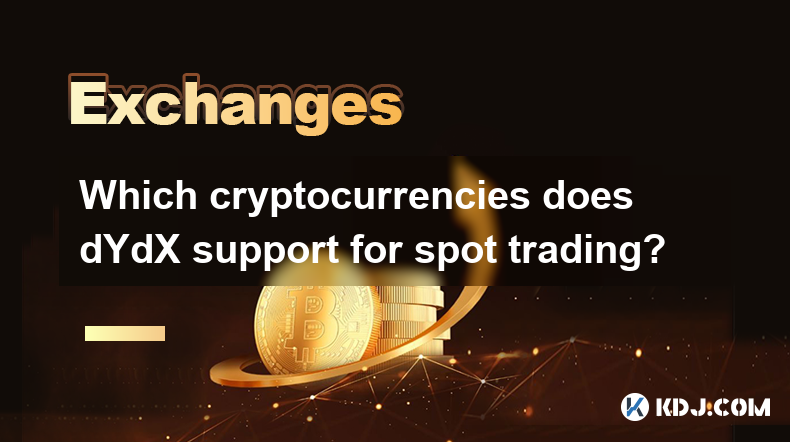
Which cryptocurrencies does dYdX support for spot trading?
Apr 08,2025 at 10:14pm
The dYdX platform is a prominent decentralized exchange that has gained significant attention within the cryptocurrency community for its robust trading features and support for various cryptocurrencies. One of the key aspects that traders often inquire about is the range of cryptocurrencies available for spot trading on dYdX. In this article, we will d...

What is the KYC certification process of dYdX?
Apr 09,2025 at 02:21am
The KYC (Know Your Customer) certification process is a critical step for many cryptocurrency platforms to ensure compliance with regulatory requirements and to prevent fraud. dYdX, a leading decentralized exchange focused on perpetual futures trading, also implements a KYC process for its users. This article will detail the KYC certification process of...

How are dYdX's trading fees calculated?
Apr 09,2025 at 03:14am
dYdX is a decentralized exchange that operates on the Ethereum blockchain, offering users the ability to trade perpetual contracts and other derivatives. One of the key aspects that users need to understand when using dYdX is how trading fees are calculated. This article will delve into the specifics of dYdX's fee structure, providing a comprehensive gu...

How do I deposit funds on dYdX?
Apr 08,2025 at 11:22pm
How do I deposit funds on dYdX? dYdX is a leading decentralized exchange that allows users to trade cryptocurrencies, engage in margin trading, and participate in perpetual contracts. One of the essential steps to start using dYdX is depositing funds into your account. This article will guide you through the process of depositing funds on dYdX, ensuring...

How does dYdX perpetual contract trading work?
Apr 09,2025 at 12:56pm
dYdX is a decentralized platform that offers perpetual contract trading, which is a type of derivative trading that allows users to speculate on the price movements of cryptocurrencies without owning the underlying assets. In this article, we will explore how dYdX perpetual contract trading works, including the mechanics of the platform, the benefits an...

How do I trade leveraged on dYdX?
Apr 09,2025 at 12:07pm
Trading leveraged on dYdX can be an exciting way to potentially amplify your returns in the cryptocurrency market. dYdX is a decentralized platform that allows users to trade with leverage, meaning you can borrow funds to increase your trading position. This guide will walk you through the process of trading leveraged on dYdX, covering everything from s...

Which cryptocurrencies does dYdX support for spot trading?
Apr 08,2025 at 10:14pm
The dYdX platform is a prominent decentralized exchange that has gained significant attention within the cryptocurrency community for its robust trading features and support for various cryptocurrencies. One of the key aspects that traders often inquire about is the range of cryptocurrencies available for spot trading on dYdX. In this article, we will d...
See all articles























































































